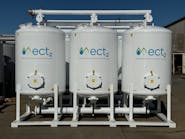The term "smart cities” implies a common misconception that only the biggest cities are capable of deploying advanced technologies and digital solutions. However, becoming more technically savvy and embracing smart city technology has never been more attainable than it is today.
The town of Cary, North Carolina, with just over 175,000 residents, is becoming one of the smartest towns in the United States. Cary started its foray into smart technology by beginning to monitor key elements of its public infrastructure. Today, the town is a smart city with consistent data collection and analysis, and the development of smart solutions to benefit the greater good of the community.
Interestingly the term “smart city” has another misconception; that a city is smart once it deploys Internet of Things (IoT) sensors to collect data. In reality, the point at which it becomes truly smart is when the sensor data is streamed into analytics wherein it enables insights and predictions to drive decisions.
The Key to Unlocking Smart City Status: Insight through Data Analytics
The town of Cary has been committed to invigorating the community for more than a decade. In 2007, the town enlisted the help of SAS, an analytics systems and solutions provider also based in Cary, to improve public safety and develop services within the town. As part of this collaboration, the town government used SAS’s software solutions to compile, organize and analyze data to make smarter, more actionable predictions for the benefit of the town and its residents. With new insights from an untapped wealth of data, municipal operations can run more efficiently by allowing town employees to access information they need, ahead of time, to help the town perform at a higher capacity than ever before.
Originally, the town had planned this as a four-year project, but successes were seen almost immediately. This led a group of key decision makers within the town to explore expanding the project’s horizons.
To add to the innovation brought by the extensive data and analytics, the town looked to cost effective and efficient IoT solutions. This was the logical next step to improve resident life, establish more sustainable practices, and lead the town of Cary to the apex of smart city innovation. By using IoT sensors — long range, low power sensors that collect data and enable analytics to provide actionable insights — IoT offers information and insight from nearly any area of Cary’s town infrastructure and community needs. Whether it’s monitoring air quality, trash can and water levels, or parking meters, IoT is helping Cary, North Carolina make smarter infrastructure decisions. But smart technologies are only as good as their deployment and ability to analyze their data.
The IoT solutions provide real-time predictions that help solve specific challenges. These insights all provide better ways to monitor and safeguard the community and its resources, and help build a more sustainable city.
The IoT sensors incorporate Low Power Wide Area Network (LPWAN) connectivity, based on Semtech’s LoRa® devices, which are developed on an open, globally accepted standard for LPWAN applications. Used in IoT networks in more than 100 countries, the LoRaWAN® standard is designed to wirelessly connect battery-operated devices to the internet in regional, national or global networks. The standard targets key IoT requirements such as bi-directional communication, end-to-end security, and mobility and localization services. LoRaWAN connectivity solves many of the challenges that smart city operators face and is well suited to facilitate data collection from key applications throughout a city or town, including streams, storm drains, energy meters, street lighting, parking, condition monitoring equipment, air quality stations, waste and recycling containers, mobile asset tracking and much more.
Providing Crucial Information Rain or Shine
Long range, lower power IoT devices offer a unique benefit for public sector applications. They have an incredible battery life, lasting up to 10 to 20 years in some cases. The low power devices reduce maintenance needs. This allows towns to operate the devices in many areas — including those that are hard to reach — and in environments that would normally require extra maintenance and extra budget for that maintenance.
Many solutions for connectivity – like Wi-Fi or cellular – can be unreliable during severe weather like hurricanes that have high winds and often flooding that knock out local infrastructure. Typically, when a building’s power goes down all connection can be lost. But long range IoT sensors connect to multiple gateways on high-points well away from any potential infrastructure damage. The result is a strong, trustworthy and resilient network connection. This type of connectivity solutions offers two-way communications and also has the ability to penetrate dense building materials to communicate in urban environments at a low operating cost, unlike Wi-Fi, which can’t operate efficiently over long distances or in remote areas. These benefits support creative city planning and development processes in everyday life as well as plans for disaster resiliency.
IoT Technology Enhances Disaster Response in Wake of Flooding
Smart technologies are only as good as the hands they are placed in and having these edge-to-cloud solutions are critical for driving innovation in the town of Cary. Historically, Cary has faced many challenges when it comes to storm drain water and flooding. As the town faces the realities of increased severe weather brought on by climate change, stormwater that runs off into roads, parking lots, sidewalks and buildings all pose hazards to residents and their property. IoT solutions have proven critical in alerting the town and its residents to potential instances of predicted flooding. With that, the town has been able to turn its disaster response from a reactive and manual process into a more predictive, proactive and automated response – often before a storm even hits. The approach to severe rain, which leads to rising water levels and flooding, has undergone a complete digital transformation.
In fact, since deploying the new IoT solutions, the town has created a Stormwater Division that is responsible for capturing, managing and analyzing floodwater data. Sensors leveraging Semtech’s LoRa technology and SAS’s data analytics solutions allow the division to measure the water height, depth, flow and rainfall totals. This data is then uploaded to the cloud and combined with other weather models to predict the strategy for Public Works, Public Safety and Information Technology departments in the town.
Planning for a Better Future
As with so many projects, there is always room for progress and additional efficiencies. The town of Cary continuously collaborates with their technology partners to innovate and further define what it means to be a smart city. While weather monitoring enables the town and its residents to protect their livelihood — from personal safety to personal belongings and shelter — the town is also looking at other solutions to improve quality of life. From trash can sensors that monitor when a public bin is full, to the development of a new downtown park area, IoT sensors are becoming part of a new model of civic public service, and offers residents a town in which everyone feels comfortable and excited to be a part of.





